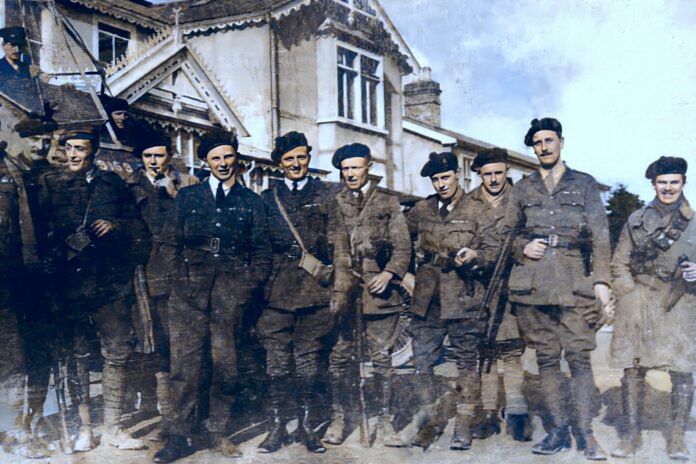This Sunday, the East Clare Memorial Committee will honour Fr. Seán Clancy, who in War of Independence, stood with his parishioners in Scariff. Historian Dr Tomás Mac Conmara reflects on his story and its connection to a famous British crime drama series.
In season five of The Peaky Blinders, the main antagonist is a British politician called Oswald Mosley. It is the late 1920s and Mosely’s covert plans for a fascist revolution have been noted at the upper echelons of British power. Thomas Shelby (played by Cillian Murphy), has been approached by Winston Churchill, to eliminate the increasingly influential Mosley. This peculiar dramatization of real historical figures connects a global television phenomenon, to east Clare in 1921.
In May that year, then twenty-five-year-old MP, Oswald Mosely spoke at length about the town of Scariff in the British House of Commons. He underlined reports that the local Catholic Priest, Fr Seán Clancy had been denied the right to celebrate mass for his parishioners.
At approximately 10.30am on Sunday, April 24, 1921, Fr Clancy was walking through Scariff, when he was held up by British Auxiliaries, who had arrived from Killaloe and begun rounding up local men. Clancy, who was born in Coolmeen in 1891, was the brother of Paddy Clancy, a commander in the West Clare IRA. More importantly, he was the curate of Scariff and had the previous November, officiated at the funeral of the Scariff Martyrs, who British forces had shot dead on the Bridge of Killaloe.
When Clancy, who had been identified as sympathetic to republicans, approached the Colonel in charge and proclaimed that he had ‘not been allowed to celebrate mass’, the response, which Clancy later characterised as ‘sarcastic’, was ‘too bad’. Clancy was then marched with other men to the local church, where despite his repeated protests that he had only until 12.00pm to perform the Catholic liturgical rite, he was prevented from saying mass. Instead, he was taken two miles outside Scariff, where Colonel Hemming declared Clancy would see ‘some of the good work his parishioners can do and some of bad work others can do’. The men were made to repair roads that had been damaged by the East Clare IRA, to impede British movements until 2.30pm, when military lorries drove away, leaving Clancy and the others to walk home.
Soon reports emerged about a Catholic priest in county Clare ‘compelled to accompany his parishioners, who were performing forced labour’. In the British House of Commons, indignation about the incident was expressed most forcefully by Mosley, then Labour Party MP for Harrow. Mosely, who had earlier left the Conservative Party, charged the British forces with having forcibly detained Fr Clancy. This was dismissed by the Chief Secretary, Hamar Greenwood, who claimed instead that the young priest had chosen to ‘accompany his flock’. In May, Clancy himself wrote to the press to rubbish Greenwood’s suggestion. In his open letter, Clancy addressed Mosely directly, thanking him for the interest he took in his case and in Ireland generally.
By the late 1920s, Mosely had grown disillusioned with mainstream politics and assumed leadership of the British Union of Fascists. As depicted in The Peaky Blinders, he fell out of favour with the British hierarchy and was later interned for three years. One who denounced Mosely as abhorrent to the political environment was Winston Churchill, at that time on the ascent towards the British premiership. There is of course a certain irony in Churchill’s apparent indignation. Back in 1921, as Mosely drew attention to the atrocities of Black and Tans and broader Crown Forces, across the floor of the House of Commons sat Winston Churchill. It was he who had devised those British forces, he who encouraged their deployment to Ireland and he who defended everything they did. Churchill even called for more hangings as punishment for the men who fought against those forces. These actions, it would seem, were acceptable to British political opinion and Churchill continued his ascent, later becoming Prime Minister. In 2002, he was voted ‘the greatest Briton’. Mosely instead left Britain in disgrace and lived most of his life in Paris, where he died in 1980. Fr. Seán Clancy was later transferred to Portroe in Tipperary, where he was buried after his death in 1964. In Scariff, Clancy’s stance on behalf of his community, despite many threats against him, was remembered.
The East Clare Memorial Committee will lay wreaths in honour of Fr. Clancy this weekend in private ceremonies, in line with Covid-19 restrictions. The Scariff Martyrs, War Murder and Memory in East Clare by Tomás Mac Conmara, will be published by Mercier Press in September 2021.


